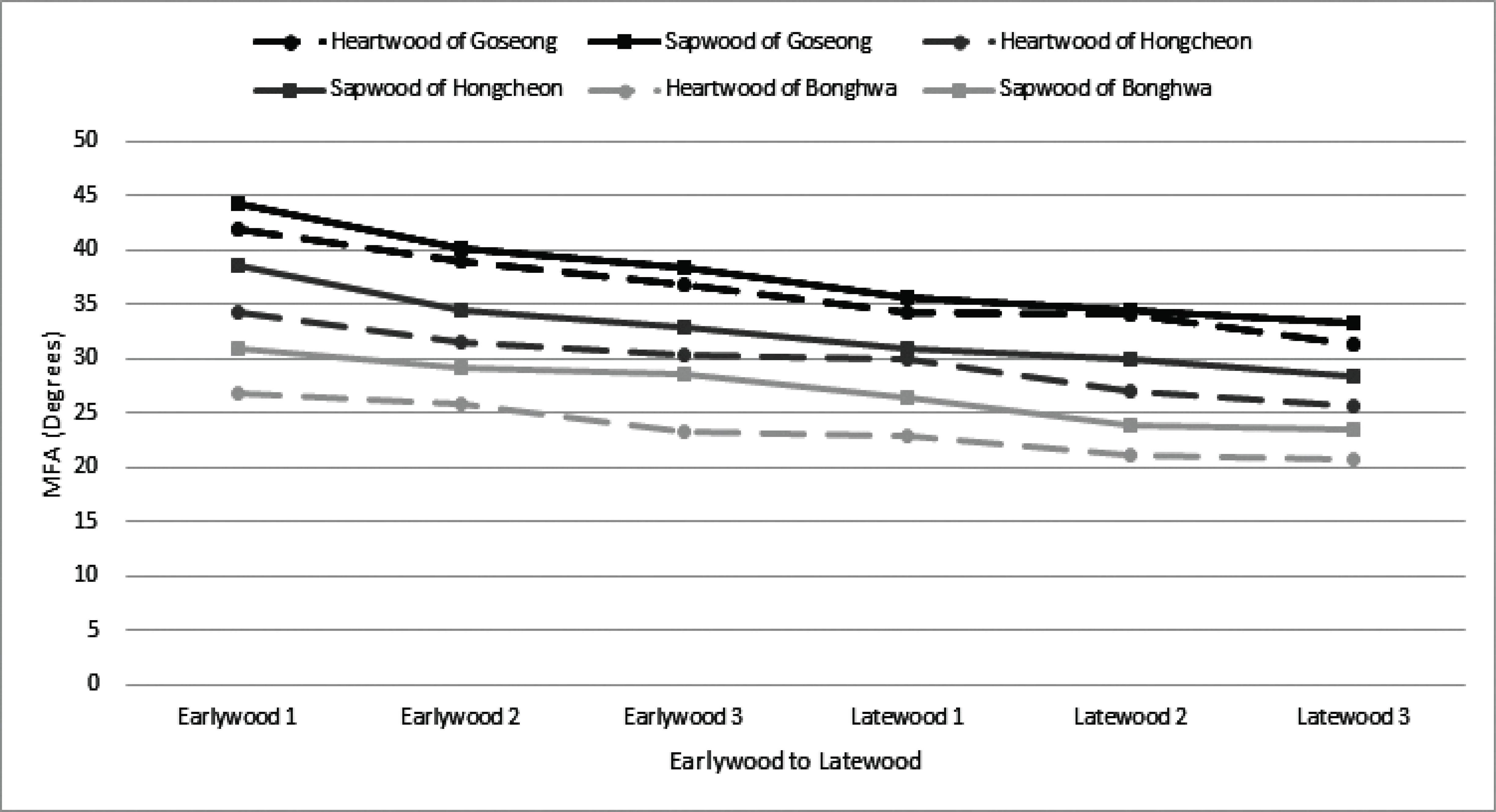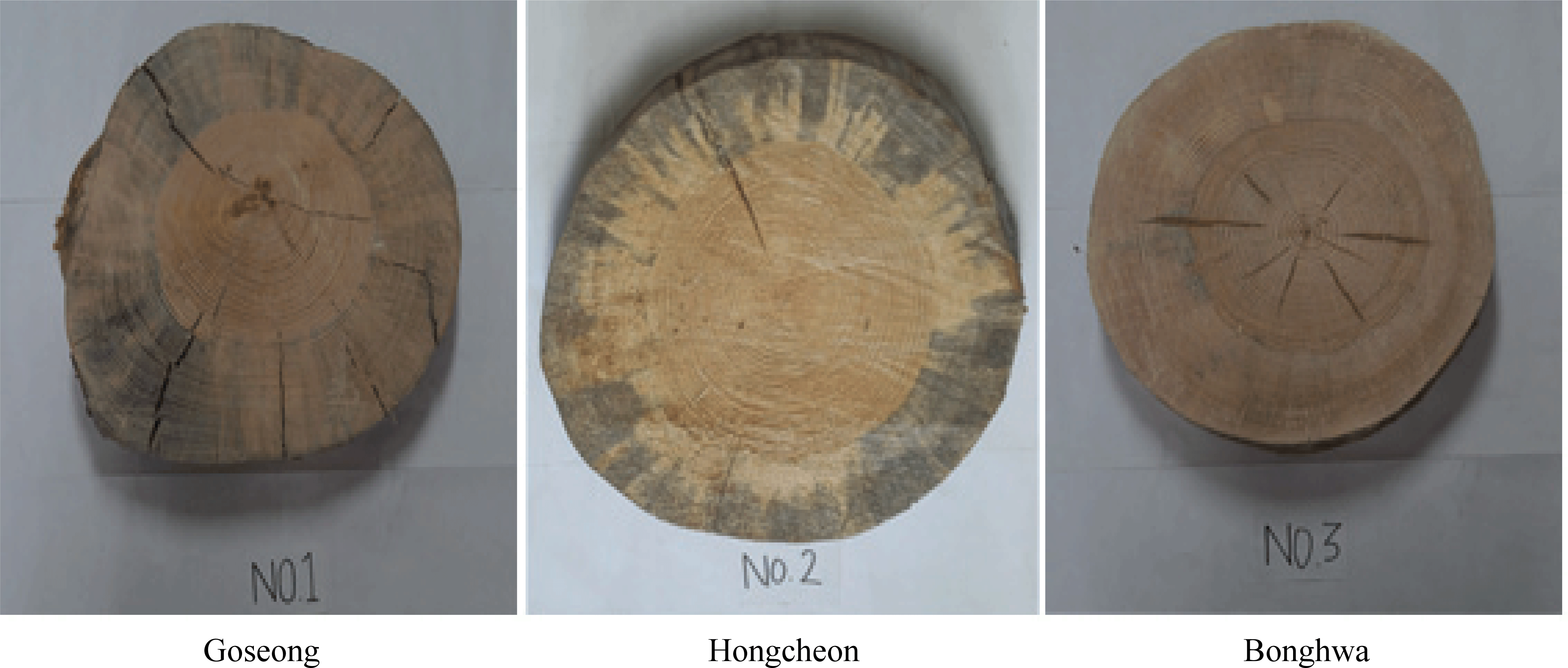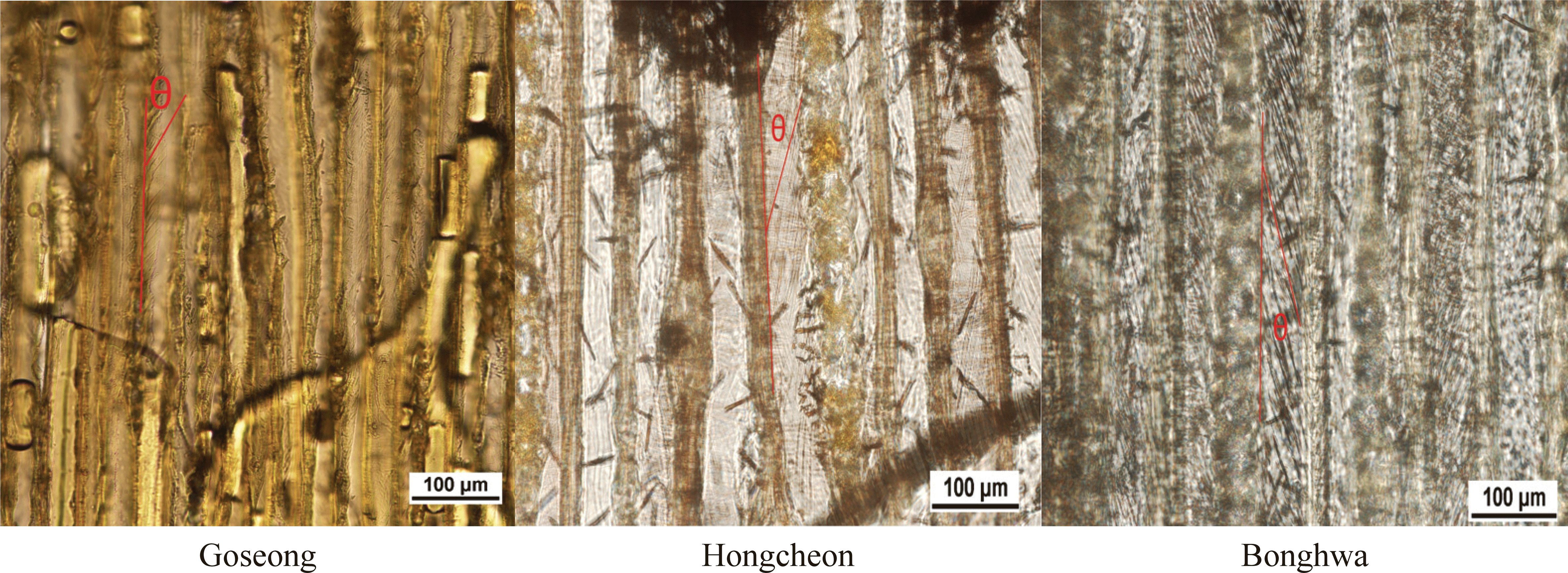1. INTRODUCTION
Pine trees are spread the most extensively in Korea as a fundamental tree species for the forest ecosystem, accounting for about 26%, the widest, of the total national forest area (KRFI, 2016). Morphologically, pine trees generally have a straight stem and, for their excellent lumber quality, have long been utilized as furniture material or building timbers for ancient palaces, temples, etc. According to the investigation on changes in wood species utilized in Korean architectural structures, pine trees are found to have been utilized in most of the structures (Park et al., 2007). Many traditional wooden architectural craftsmen and concerned persons who deal with Korean pine tree lumbers say that pine trees have different quality depending upon areas. In a survey on any difference in pine tree quality according to areas, about 70% of the respondents answered there were differences (Han et al., 2015). The cell wall of cells comprising lumber has a laminated structure which can be separated to primary wall and secondary wall. The secondary wall consists of S1, S2 and S3 layers. Each layer has different microfibril orientation. The microfibril orientation of the thickest layer of secondary wall, S2, has a huge impact on the physical and mechanical properties of lumber (KFRI, 2014). Microfibril angle (MFA) refers to the angle between cell axis and microfibril orientation of secondary-wall S2 layer. The MFA is one of the important factors evaluating lumber quality (Bergander et al., 2000). Therefore, many related studies have been reported. Oh (1997) reported that compression strength decreased with the increase in the cell height and MFA of uniseriate ray. Eun et al. (2008) studied 3 needleleaf tree species (Pinus densiflora S. et Z., Pinus koraiensis S. et Z., Pinus rigida Mill.) and found that microfibril was larger around the pith part and decreased toward the bark until 15 ~ 20 annual rings before it stabilized. Rlee et al. (2005) reported that the microfibril angle was larger in the earlywood part than latewood part while generally showing no significant difference between the south and north sides of the pith. Park et al. (2006), in their study on the variation of material properties of pine tree of superior families, found the microfibril angle range of 9.0 ~ 28.6°, wide differences between families. The studies of pine trees characteristics by region include the physical and mechanical properties of Korean red pine wood from different growth sites and correlations between them (Han et al., 2016), seasonal change of cambium activity of pine trees at different growth sites (Park et al., 2015), establishing local master ring-width chronologies (Oh et al., 2017). In addition, studies on the identification of tree species have compared of cellular anatomical, physical and mechanical properties between Dahurian larch and Japanese larch (Han et al., 2017), effects of density, temperature, size, grain angle of wood materials on non-destructive moisture meters (Pang and Jeong, 2019), performance enhancement of automatic wood classification of Korean softwood by ensembles of convolutional neural networks (Kwon et al., 2019).
The previous research of this present study is the study on the anatomical characteristics of Korean pine trees according to area. The paper found differences in tracheid lengths and diameters according to Yeongdong (Goseong), Yeongseo (Hongcheon) and Yeongnam (Bonghwa) regions (Kim et al., 2018A). Moreover, a study on their physical characteristics reported that pine trees from different areas had different shrinkage, and the lateral shrinkage and tracheid length had a proportional relationship (Kim et al., 2018B).
This present study, building on the studies on the anatomical and physical characteristics of pine trees according to their areas of growth, seeks to investigate pine-tree microfibril angle to see if there is any difference according to their places of growth and analyze the relationship with the anatomical and physical characteristics in order to identify lumber quality characteristics depending upon areas.
2. MATERIALS and METHODS
Pine trees from Yeongdong (Goseong), Yeongseo (Hongcheon) and Yeongnam (Bonghw) retained in the Forestry Association’s East Sea Distribution Center were transferred in 2015 for this study experiment. This is the same disk as previous studies of this study, Kim et al. (2018A) and Kim et al. (2018B). At the point of transfer, they were in a disk form with the thickness of about 20 cm (Fig. 1). Table 1 exhibits their tree rings, chest diameter, average annual ring width, latewood proportion and tree trimming year.
| Province | No. of Tree ring | Diameter (cm) | Average annual ring width (cm) | Latewood ratio (%) | Tree trimming year |
|---|---|---|---|---|---|
| Goseong | 85 | 48 | 3.1 | 22.87 | 2013 |
| Hongcheon | 82 | 42 | 2.6 | 20.19 | 2012 |
| Bonghwa | 76 | 45.5 | 3.1 | 18.57 | 2014 |
Specimens were made with the disks from the three places in the size of 1.5 × 1.5 × 1.5 cm including the heartwood part (1959 ~ 1961, 3 annual rings) and sapwood part (2002 ~ 2004, 3 annual rings). The specimens were softened and divided into earlywood and latewood at each annual ring to make 3 tangential section pieces each in the thickness of 20 ~ 24 μm using Microtome. The sample pieces were soaked into Schultze, dehydrated using alcohol series (10, 30, 60, 80, 100%), and placed on the slide glass to process using 3~4% iodine-potassium iodide. Then, 50% nitric acid was dropped to form needle crystal and make permanent preparation using permount (Park et al., 1993). They were observed with multimedia image microscope (Ni KON JP/E cl l paa 801), then, 45 microfibril angles were filmed and measured on each slide using NIS (NIS-E lements BR 4.50.00 64-bit) program (Fig. 2).
3. RESULTS and DISCUSSION
Table 2 shows the heartwood part and sapwood part of pine trees from the three areas and microfibril angle of their earlywood and latewood. The average of area-specific microfibril-angle heartwood part and sapwood part and their earlywood and latewood was 37.35°, the highest, for those from Goseong Mountain, followed by Hongcheon Mountain with 32.42°, and Bonghwa Mountain, 25.75°, the smallest (Table 2). In terms of heartwood part and sapwood part, all the three mountain areas had larger microfibril angle in sapwood part than heartwood part. With respect to earlywood and latewood, the three places showed larger microfibril angle in earlywood than latewood. Eun et al. (2008) reported in their study on microstructure variation in the stem of main Korean needleleaf woods that microfibril angle was the largest at the pith of pine tree and declined until 15 ~ 20 annual rings along the annual ring increase towards the bark before stabilizing; and microfibril angle also decreased as a tree grew from juvenile wood to mature wood. Lee et al. (2015) studied the characteristics of yellowhearted pine and reported that microfibril angle at the pith part (21 annual rings) was 35 ~ 40°; mid part (81 annual rings), 25 ~ 30°; and bark part (141 annual rings), 20 ~ 35°; and the angle grew smaller towards the bark part. This present study found microfibril angles growing wider towards the bark (sapwood part) from pith (heartwood part) in all of the three places, showing difference from the findings by Eun et al. (2008), Lee (2016) and Lee et al. (2015). Additional investigation seems necessary in this regard. As preceding studies such as Kim et al. (1998), Lee et al. (2015), KFRI (2014), and Eun et al. (2008), this present study also reported that latewood microfibril angle was smaller than earlywood angle, indicating the same results in this study as well.
Table 2 is also about Duncan test using IBM SPSS Statistics 24 to examine if there was any difference in microfibril angle of earlywood and latewood as well as heartwood part and sapwood part of pine trees from the three areas. In the heartwood part, the earlywood of Goseong Mountain had 36.56°; Hongcheon Mountain, 33.31°; and Bonghwa Mountain, 24.61°; and the latewood of Goseong Mountain had 32.59°; Hongcheon Mountain, 26.25°; and Bonghwa Mountain, 21.14°. In the sapwood part, the earlywood of Goseong Mountain had 41.45°; Hongcheon Mountain, 37.98°; and Bonghwa Mountain, 30.93°; and the latewood of Goseong Mountain was 38.78°; Hongcheon Mountain, 32.13°; and Bonghwa Mountain, 26.27°, indicating Goseong Mountain was the largest, followed by Hongcheon Mountain and Bonghwa Mountain in order. Statistical processing was implemented to see if there was any difference between them. As a result, significant differences were observed among the three areas in general, excepting the earlywood of sapwood part, which showed no significant difference between Goseong Mountain and Hongcheon Mountain.
In the previous study on the anatomical characteristics of the three mountain areas, the tracheid length was measured by separating the heartwood part (1955 ~1964) and sapwood part (2002~2011). The study reported that the measurements were found the largest in trees from Bonghwa Mountain, followed by Hongcheon Mountain and Goseong Mountain in order (Kim et al., 2018A). In terms of the relationship between the tracheid lengths above and microfibril angles of this present study; the longer the tracheid lengths, the narrower the microfibril angles were found. Kim et al. (1998), KFRI (2014), Rlee et al. (2005), Hiller (1964), Mark (1967), Preston (1952), Wellwood (1962), Wadanabe et al. (1964) and others reported a negative correlation between tracheid length and microfibril angle as microfibril angle grew narrower, tracheid length was longer and the angle was wider as tracheid length was shorter. In the preceding study on the physical characteristics of trees from the three mountain areas, shrinkage from green to air dry and shrinkage from green to ovendry were measured in the tangential direction. The shrinkage from green to air dry of Goseong Mountain was 2.86 %; Hongcheon Mountain, 3.94 %; and Bonghwa Mountain, 4.39 %. The shrinkage from green to ovendry of Goseong Mountain was 6.32 %; Hongcheon Mountain, 6.58 %; and Bonghwa Mountain, 9.85 %, indicating that both conditions had the largest measurement in trees from Bonghwa Mountain, followed by Hongcheon Mountain and Goseong Mountain (Kim et al., 2018B). In terms of the relationship between the shrinkage above and microfibril angle of this present study; the larger the shrinkage from green to air dry and shrinkage from green to ovendry, the narrower the microfibril angle was found. Barber et al. (1964) and Kim et al. (1998) reported that, as microfibril angle increased, longitudinal shrinkage rose; and, as the former decreased, lateral shrinkage increased. Therefore, of the physical characteristics found by Kim et al. (2018B), differences between mountain areas seem to have been caused by tracheid length (Kim et al., 2018A) and microfibril angle of this present study. Such differences seem to be due to each mountain area’s topography, soil, climate, etc. Study related to this aspect will need to be implemented in the future as well.
Fig. 3 exhibits microfibril angle variations within a single annual ring of the heartwood part and sapwood part of pine trees from Goseong Mountain, Hongcheon Mountain and Bonghwa Mountain. All the three mountain areas showed smaller angle variations from earlywood to latewood. Lee et al. (2015), in their study on the quality characteristics of yellow-hearted pine, round that, in a single annual ring, microfibril angles were larger in earlywood than latewood. The researchers also measured earlywood and latewood microfibril angles in 21 and 51 annual rings and found that earlywood was 28.26°; and latewood, 25.75°, demonstrating angles narrowing from earlywood to latewood. Chun et al. (1983), in the study on microfibril angle of lumbar cell wall, reported that the microfibril angles of normal nut-tree lumbar stem averaged 17.6°; earlywood part, 19.8°; and latewood part, 15.3°, finding larger angles in earlywood than latewood, consistently with this present study.

4. CONCLUSION
In this present study, microfibril angle characteristics were examined in order to see if there was any difference in pine tree quality depending upon their growth areas - Yeongdong (Goseong), Yeongseo (Hongcheon) and Yeongnam (Bonghwa) surrounding the Taebaek Mountains. The microfibril angles showed difference according to areas. In terms of the heartwood and sapwood parts and their earlywood and latewood, Goseong Mountain was measured to have 37.35°; Hongcheon Mountain, 32.42°; and Bonghwa Mountain, 25.75° in general. In the comparison between heartwood and sapwood part, the sapwood part showed larger measurement than heartwood part. Between earlywood and latewood, the earlywood had bigger angles than latewood. Variation in a single annual ring was found narrower from earlywood to latewood. Microfibril angles with regional difference were found to have an impact on a physical property (shrinkage) together with the anatomical characteristic (tracheid length).


